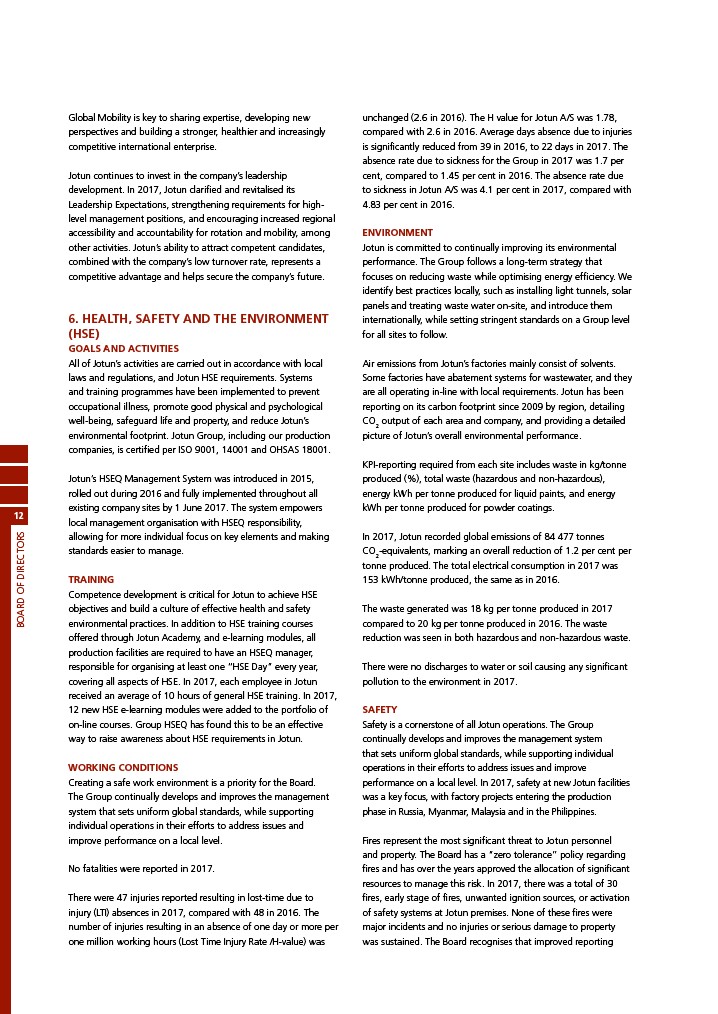
12
BOARD OF DIRECTORS
Global Mobility is key to sharing expertise, developing new
perspectives and building a stronger, healthier and increasingly
competitive international enterprise.
Jotun continues to invest in the company’s leadership
development. In 2017, Jotun clarified and revitalised its
Leadership Expectations, strengthening requirements for highlevel
management positions, and encouraging increased regional
accessibility and accountability for rotation and mobility, among
other activities. Jotun’s ability to attract competent candidates,
combined with the company’s low turnover rate, represents a
competitive advantage and helps secure the company’s future.
6. HEALTH, SAFETY AND THE ENVIRONMENT
(HSE)
GOALS AND ACTIVITIES
All of Jotun’s activities are carried out in accordance with local
laws and regulations, and Jotun HSE requirements. Systems
and training programmes have been implemented to prevent
occupational illness, promote good physical and psychological
well-being, safeguard life and property, and reduce Jotun’s
environmental footprint. Jotun Group, including our production
companies, is certified per ISO 9001, 14001 and OHSAS 18001.
Jotun’s HSEQ Management System was introduced in 2015,
rolled out during 2016 and fully implemented throughout all
existing company sites by 1 June 2017. The system empowers
local management organisation with HSEQ responsibility,
allowing for more individual focus on key elements and making
standards easier to manage.
TRAINING
Competence development is critical for Jotun to achieve HSE
objectives and build a culture of effective health and safety
environmental practices. In addition to HSE training courses
offered through Jotun Academy, and e-learning modules, all
production facilities are required to have an HSEQ manager,
responsible for organising at least one “HSE Day” every year,
covering all aspects of HSE. In 2017, each employee in Jotun
received an average of 10 hours of general HSE training. In 2017,
12 new HSE e-learning modules were added to the portfolio of
on-line courses. Group HSEQ has found this to be an effective
way to raise awareness about HSE requirements in Jotun.
WORKING CONDITIONS
Creating a safe work environment is a priority for the Board.
The Group continually develops and improves the management
system that sets uniform global standards, while supporting
individual operations in their efforts to address issues and
improve performance on a local level.
No fatalities were reported in 2017.
There were 47 injuries reported resulting in lost-time due to
injury (LTI) absences in 2017, compared with 48 in 2016. The
number of injuries resulting in an absence of one day or more per
one million working hours (Lost Time Injury Rate /H-value) was
unchanged (2.6 in 2016). The H value for Jotun A/S was 1.78,
compared with 2.6 in 2016. Average days absence due to injuries
is significantly reduced from 39 in 2016, to 22 days in 2017. The
absence rate due to sickness for the Group in 2017 was 1.7 per
cent, compared to 1.45 per cent in 2016. The absence rate due
to sickness in Jotun A/S was 4.1 per cent in 2017, compared with
4.83 per cent in 2016.
ENVIRONMENT
Jotun is committed to continually improving its environmental
performance. The Group follows a long-term strategy that
focuses on reducing waste while optimising energy efficiency. We
identify best practices locally, such as installing light tunnels, solar
panels and treating waste water on-site, and introduce them
internationally, while setting stringent standards on a Group level
for all sites to follow.
Air emissions from Jotun’s factories mainly consist of solvents.
Some factories have abatement systems for wastewater, and they
are all operating in-line with local requirements. Jotun has been
reporting on its carbon footprint since 2009 by region, detailing
CO2 output of each area and company, and providing a detailed
picture of Jotun’s overall environmental performance.
KPI-reporting required from each site includes waste in kg/tonne
produced (%), total waste (hazardous and non-hazardous),
energy kWh per tonne produced for liquid paints, and energy
kWh per tonne produced for powder coatings.
In 2017, Jotun recorded global emissions of 84 477 tonnes
CO2-equivalents, marking an overall reduction of 1.2 per cent per
tonne produced. The total electrical consumption in 2017 was
153 kWh/tonne produced, the same as in 2016.
The waste generated was 18 kg per tonne produced in 2017
compared to 20 kg per tonne produced in 2016. The waste
reduction was seen in both hazardous and non-hazardous waste.
There were no discharges to water or soil causing any significant
pollution to the environment in 2017.
SAFETY
Safety is a cornerstone of all Jotun operations. The Group
continually develops and improves the management system
that sets uniform global standards, while supporting individual
operations in their efforts to address issues and improve
performance on a local level. In 2017, safety at new Jotun facilities
was a key focus, with factory projects entering the production
phase in Russia, Myanmar, Malaysia and in the Philippines.
Fires represent the most significant threat to Jotun personnel
and property. The Board has a “zero tolerance” policy regarding
fires and has over the years approved the allocation of significant
resources to manage this risk. In 2017, there was a total of 30
fires, early stage of fires, unwanted ignition sources, or activation
of safety systems at Jotun premises. None of these fires were
major incidents and no injuries or serious damage to property
was sustained. The Board recognises that improved reporting